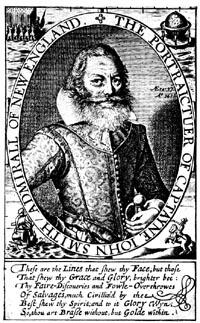|
FRESH STUFF DAILY |
|
|
||
|
|
||
|
|
||
|
SEE ALL SIGNED BOOKS by J. Dennis Robinson click here |
||
Page 2 of 3
A hard man to kill, Smith recovered. His book "A True Relation" about the first years of Jamestown made him the toast of literary London. His honesty and radical ideas, however, frustrated the rich and famous who were investing heavily in the New World experiment. The corporate "money men" were looking to get rich quick. Like the Spanish in South America, they wanted gold. Smith had searched hard, found no gold, and said so. Smith advocated a slower return on investment through farming and trading with the Natives. Investors saw the independent-minded military man as a threat and tried to sabotage the publication of his second book, "The Proceedings of the English Colony in Virginia." Smith got the book out, and it rocketed up the bestseller charts.
Here Smith turned his sights on uncharted "Northern Virginia" which at that time stretched into modern day Canada. His strategy was simple. Though he promised investors he would search for gold and jewels, Smith quietly equipped his two ships, The Frances and The Queen Anne, with fishing and whaling gear. With a hand-picked low-budget skeleton crew, Smith was off to America and back within six short months, but the impact of his trip continues to this day. Although Smith found no gold, he brought back a motherlode of furs, dried fish and fish oil. Investors were jubilant. In one short trip they were able to buy both ships, pay off the small crew, give Smith a tidy sum and still they had 8,000 British pounds in profit. While his men had been fishing the cod rich banks of "New England" as he named the area, Smith had sailed from Nova Scotia to Rhode Island in a small portable boat. His sketch became the first accurate map of New England - the map that would ultimately lead Europeans in droves to a brave new world. Now comes the point in this tale where history makes less sense than what almost happened. Captain John Smith was suddenly the hottest investment in London, and Smith wanted to return to New England to found a permanent colony. Unlike in Virginia, Smith's New England colonists would be tough, skilled and quickly self-supporting. They would not waste their time hunting for gold, but would fish, hunt whales, trap for fur and cut the abundant timber. They would work with, not against the native tribes. This was a long term, low-risk proposition, Smith explained. Smith had scouted a number of ideal spots including Monhegan Island in Maine, others near modern day Boston and Plymouth, Massachusetts, and an area now called Portsmouth, New Hampshire near the Isles of Shoals, which he named "Smith Isles" after himself. In 1615 Smith set sail, fully equipped, with his team of supercolonists, determined to start the first permanent colony in New England. It was over in days. Within 400 miles of England the two ships were ravaged by a killer storm, and by the time they limped back to London, they were only good for salvage. CONTINUE to read the CAPTAIN JOHN SMITH Please visit these SeacoastNH.com ad partners.
News about Portsmouth from Fosters.com |
| Tuesday, April 23, 2024 |


|
Copyright ® 1996-2020 SeacoastNH.com. All rights reserved. Privacy Statement
Site maintained by ad-cetera graphics

 Link Free or Die
Link Free or Die



 Despite his fame, dressed in fox fur and armor, Smith was out of place in civilized London. He was dying for another adventure, and to prove that his ideas on colonization were the best. In his absence, Jamestown had all but fallen to bits when about 500 colonists died of starvation, some even turned to cannibalism. Radical or not, Smith's ideas were starting to make sense.
Despite his fame, dressed in fox fur and armor, Smith was out of place in civilized London. He was dying for another adventure, and to prove that his ideas on colonization were the best. In his absence, Jamestown had all but fallen to bits when about 500 colonists died of starvation, some even turned to cannibalism. Radical or not, Smith's ideas were starting to make sense.














